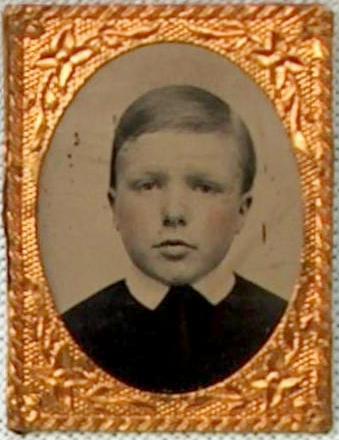
Tin-type Portraits: Little Gems

Figure 1.--Here we have an early Gem tin-type portrait. The image here is larger than the sctual se which was the stadard 1 inch high and 3/4 inch wide. It is undated, but becaise it is framed like Dags and Ambros, we suspect it was very early Civil War-era Gem, perhaps about 1863-65. Paper sleeves were much more common. The unidentified American boy wears a collar-buttoning jacket with a small white collar.
|
|
Photographers introduced tiny Little Gem portraits in 1863. The Little Gem was a type of tin-type. The very small portraits 7/8 by 1 inch (about the size of a small postage stamp) debuted with the invention of the Wing multiplying camera. This meant just one eposure could produce mukltiple images, a factor in reducung costs. The small size was another factor. They were popularized under the trade name Little Gems, but came to be called simply Gems. These tiny images were popular because they provie an inexpensive way of sending phitographs to large numbers of friends and families. They were also just the right sizes for lockets or similar jewelry items holding small photographs. Special Gem galleries soon appeared and flourished for several decades. The Gem image brought the price for a photograph to an all time low. Often imprints found on carte de visite backs will indicate they were made in a Gem studio, but the carte de visite is not a Gem image. Most photographers were required to offer a versatile range of services and images types to stay in business. Gem portraits were stored in special albums that held one image per page. Also, larger albums were made that held several of the small images per page, perhaps holding as many as a hundred portraits. These These tiny images had many uses and the substantial metal surface was actually useful in the mounting. Gems were easily cut to fit lockets, cufflinks, tiepins, rings and even garter clasps. We know that Gems were a popular format in America, we know very little about other countries. Gems began to decline about 1890, when the introduction of family cameras made began to make visits to studios that specialized in the tiny likenesses or card mounted photographsless necessary. The appearance of the simple Kodak Brownie (1900) was the final stp in this process.
HBC

Navigate the Boys' Historical Clothing Web Site:
[Return to: Main tintype page]
[Return to: Main photography page]
[Introduction]
[Activities]
[Biographies]
[Chronology]
[Clothing styles]
[Countries]
[Bibliographies]
[Contributions]
[FAQs]
[Glossaries]
[Images]
[Links]
[Registration]
[Tools]
[Boys' Clothing Home]
Navigate the Boys' Historical Clothing Web Site:
[Sailor suits]
[Sailor hats]
[Buster Brown suits]
[Eton suits]
[Rompers]
[Tunics]
[Smocks]
[Pinafores]
Created: 6:00 AM 6/26/2012
Last updated: 6:00 AM 6/26/2012



